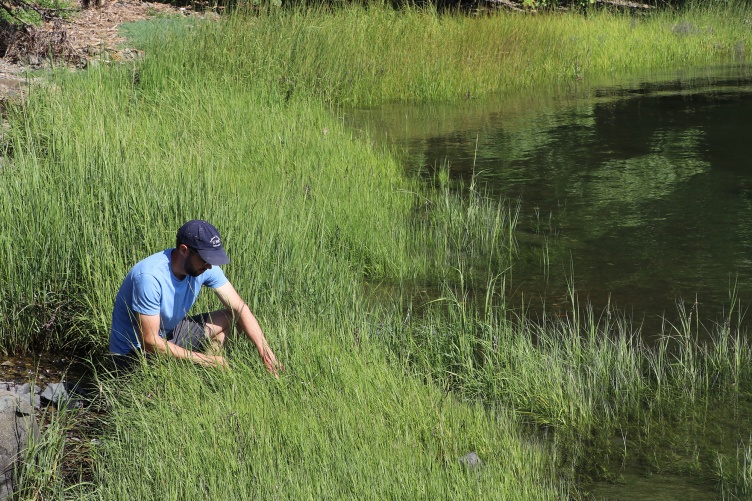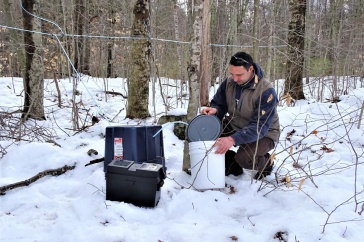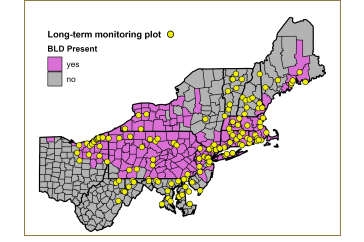
Andy Payne in a Great Bay salt marsh.
New UNH research is shedding light on why salt marshes are being lost to sea level rise and how to save them from destruction. The study, which was recently published in the scientific journal Estuaries and Coasts, is the first to assess the impact of flooding stress on belowground plant growth in a Gulf of Maine salt marsh and link the results directly to the marsh’s ability to keep pace with rising sea level.
Salt marshes rely heavily on their plants’ underground root production to increase their elevation, but data from the study reveals that increased flooding slows the rate of underground growth, halting its contributions to marsh elevation. The results point to the need for interventions such as restoring sediment sources or opening up areas where marshes can migrate upland to help these important coastal ecosystems keep up with sea level rise.

Over a two-year period, Andrew Payne, who graduated from UNH in 2018 with a master’s degree in natural resources and led the study, and UNH College of Life Sciences research associate professors David Burdick and Gregg Moore examined the effect of flooding on belowground plant productivity in the Great Bay Farms marsh in the eastern side of the Great Bay Estuary in Newington, New Hampshire.
They used data collected from three sets of pots, one containing the high marsh plant Spartina patens, one with the low marsh plant Spartina alterniflora and one with just soil, arranged in apparatuses called “marsh organs” — named for their resemblance to a pipe organ — that were installed over a range of elevations in the marsh. The researchers also looked at data on sediment accumulation and soil erosion and compaction, factors that also affect marsh elevation, using tools that measure net elevation changes, some of which have been providing data on Great Bay marshes since the mid-1990s.
The study represented the first time a marsh organ was used to isolate the effects of flooding on belowground plant productivity and relate it directly to elevation change.
"We know less than we think we know when it comes to salt marsh conservation."
Salt marshes are complex coastal habitats that are divided into low marsh zones, which are located along the seaward edge and typically flood at every tide, and high marsh zones, which lie between the low marsh and the upland area and typically only flood during higher than average high tides. Marshes have several important functions: they mitigate coastal flooding, improve water quality, provide an important habitat for plants and wildlife and store carbon.
Natural processes — plant growth, sediment deposits and movement upland — had made it possible for salt marshes to keep up with the relatively minuscule increases to sea level over the last 4,000 years and maintain the ecosystem’s delicate balance.
But all that has changed since global warming quickened the pace of sea level rise. Now, says Payne, climate change is bringing higher tides that cause the marsh to stay flooded for longer periods of time. This change is especially threatening to high marsh areas that are less accustomed to flooding.
As for the Great Bay Farms marsh, Payne, Burdick and Moore found that at every elevation neither plant species in the marsh organs produced enough belowground material under flooding stress to adequately increase marsh elevation. The data did show, however, that tides brought large amounts of sediment to the low marsh area, which could help build the elevation in low-lying marsh areas as sea level rises.
Payne hopes the results of the study will help resource managers make smart decisions regarding needed interventions to restore and protect these important coastal ecosystems.
“We know less than we think we know when it comes to salt marsh conservation,” says Burdick. “We are hoping that future researchers will focus more on understanding salt marsh belowground dynamics and that resource managers will recognize that sediment supplies are probably going to be more and more important as marshes lose elevation. We’ve trapped all our sediment supplies with development: with dams and by making inlets and fortifying them so they can’t move back and forth.”
For high marsh areas, this information can’t come soon enough. Prior studies have predicted that as a result of sea level rise all high marshes could disappear by 2100, taking with them many plant and wildlife species.
Payne, Burdick and Moore’s paper, “Potential Effects of Sea-Level Rise on Salt Marsh Elevation Dynamics in a New Hampshire Estuary,” has been selected as the editor’s choice for the September issue of Estuaries and Coasts.
Permission to install the experiment and surface elevation tables was granted through the Great Bay National Estuarine Research Reserve. Funding for this research was provided by the University of New Hampshire Graduate School, the University of New Hampshire Marine Biology Program, the William Spaulding Endowment in Support of Marine Biology Research at the Jackson Estuarine Laboratory, the Society for Ecological Restoration Laderman Student Grant, and the Maine Association of Wetland Scientists.
-
Written By:
Sarah Schaier | College of Life Sciences and Agriculture





















































